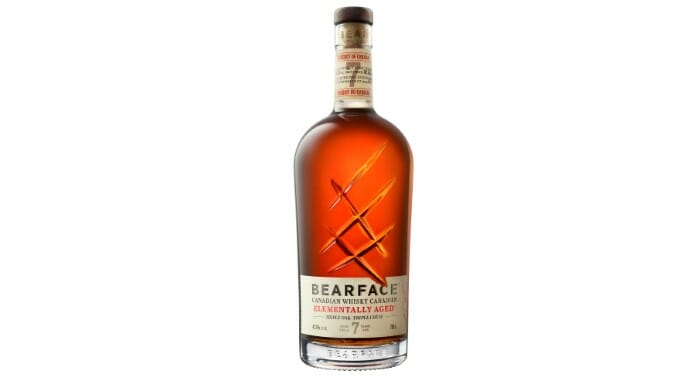Bearface Triple Oak Canadian Whisky
Photos via Bearface Whisky
On one level, the oak cask is the most basic and fundamental building block of whiskey maturation, but as any whiskey devotee knows, simply specifying “oak cask” is an extremely broad qualifier, like designating a part of one’s breakfast as simply “fruit.” Different species of oak impart drastically different flavor profiles to an aging spirit, but even the same type of oak—from the same tree, even—will read very differently depending on how it’s been dried and treated. And that’s before one even gets into the world of re-used oak barrels that have previously been used to age various styles of wine, beer or spirits. The world of “oak casks” is a constellation of possibilities.
Seemingly all of those possibilities, meanwhile, are the goal of the exploration going on in Bearface Triple Oak Canadian Whisky, an eccentric and ambitious Canadian brand that is not only combining multiple styles of oak cask, but housing those casks in a thoroughly unusual setting. Using a process they’ve dubbed “Elemental Aging,” Bearface whiskeys undergo their finishing process in the wilds of British Columbia, aging in shipping containers where they’re exposed to the constantly rotating temperature swings of the region.
Explaining the actual process that is undergone by Bearface before it’s bottled is a little bit complex, so let me summarize via bullet points.
— Bearface starts as sourced, 100% corn whisky from Canada—this is the standard method used by most of the larger Canadian distilleries, which typically distill and age a variety of 100% grain distillates (such as corn, rye and malt), and then blend those aged spirits together to create finished products. In Bearface’s case, they’ve sourced 7-year-old corn whisky aged in ex-bourbon casks from a single distillery, meaning this can accurately be described as “single grain whisky.”
— The whisky then undergoes not one but two finishing periods of secondary aging in shipping containers in “bear country.” It first rests in a mixture of French Oak and American oak casks that previously held red wine. After several months in the wine casks, the whisky is then transferred to toasted virgin Hungarian Oak casks, which have been treated with a variety of toast levels. These are exclusively toasted and not full-on charred.
— The whiskey is then cut to 42.5% ABV (85 proof) and bottled, with a fairly approachable MSRP of $35. Considering the complexity of the finishing process, and the respectable age statement the whisky had coming into it, this price point actually seems a little bit surprisingly low to me.
-

-

-

-

- Curated Home Page Articles By Test Admin October 21, 2025 | 3:10pm
-

- Curated Home Page Articles By Test Admin October 21, 2025 | 2:57pm
- Urls By Test Admin October 21, 2025 | 2:57pm
- Curated Home Page Articles By Test Admin October 21, 2025 | 2:55pm
-

-

-

-

-

-

-

-

-

-

-

-

-

-

-

-

-

-

-

-

-

-

-

-

-

-

-

-

-

-

-




































